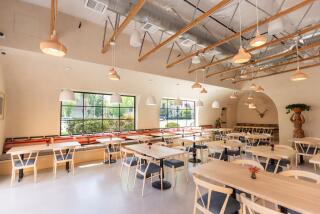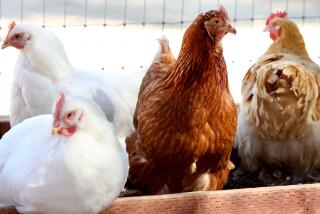Tanks Cited in Salmonella Surge : Food Safety: Harmful bacteria migrate among chickens pooled in huge vats of water, study shows.
- Share via
A commonly used processing technique is responsible for the elevated Salmonella contamination rates in raw chicken, according to a federal study.
Researchers found that the number of chicken carrying the harmful bacteria triples when carcasses are pooled in huge tanks of chilled water in the plant.
The report, which appeared in a recent issue of the Journal of Food Protection, was prepared by H. S. Lillard, a researcher with the U.S. Department of Agriculture in Athens, Ga.
The poultry industry is attempting to solve the problem, but health officials say it could be as much as a year before any effective methods are implemented.
“(The study) is nothing alarming,” said Kenneth N. May, scientific adviser for the National Broiler Council, a Washington-based trade association.
The “chiller tank” was identified as the most likely place for cross-contamination to take place. Salmonella-free birds are routinely thrown together with chicken potentially infected with the bacteria, giving the Salmonella the opportunity to migrate from one bird to another.
As in the past, federal officials involved with the nation’s meat inspection program said that the bacteria’s presence is not cause for concern because proper storage, handling and cooking of chicken will destroy the organism and prevent illness.
A top USDA official also said that even though the chiller tank seems to increase the Salmonella contamination, it also serves a useful purpose in dissipating the bacteria’s concentration on some birds. Namely, more chickens wind up contaminated but the extent of the bacteria’s presence is lessened.
“Dilution of the total number of organisms per bird is a good development,” said Lester Crawford, administrator of the USDA’s Food Safety and Inspection Program. “The fewer (cells) per bird the better off you are because a certain number of cells is needed to cause disease . . . “
May, of the Broiler Council, also emphasized that reducing the number of bacteria per bird is a positive processing technique. “The paper shows overall that our processing procedures are good because we are reducing the number of organisms (per carcass) as we go through the plant “ he said.
Crawford estimated that as many as 500,000 Salmonella cells are required to cause illness. That number drops rapidly, however, for those considered at high risk such as infants, pregnant women, the elderly and others with impaired immune systems such as cancer or AIDS patients.
Lillard acknowledged that the number of Salmonella cells found in her research were small, about one per gram of material tested. Even so, a few cells can multiply into a greater health threat in the home or restaurant if the chicken is improperly handled or stored.
Lillard found that in the five poultry processing steps prior to immersion in the chiller tank only 11% to 19% of the samples tested positive for Salmonella. However, after the birds were pooled in the chiller tank the contamination rate jumped to 36.9% of the total, or an increase of anywhere from 94% to 235%.
She also tested the chiller tank water and found it to be positive for Salmonella 53% of the time.
“Significant cross contamination occurred at only one of six sampling points throughout the plant tested,” according to Lillard. “A significant increase in Salmonella incidence for carcasses occurred only after immersion chilling, suggesting that this process is more conducive to cross-contamination than other processing points in the plant.”
Federal health officials and industry representatives have long known that the chiller tanks were a potential contamination point. However, Lillard’s data is the best to date on the problem.
“The Lillard study shows that (the chiller tank) is where substantial contamination occurs,” said Rod Leonard, executive director of the Community Nutrition Institute, a Washington-based consumer group.
Originally, scientists believed that the addition of chlorine, at a level not to exceed 20 parts per million, was sufficient to control the spread of Salmonella in the chiller tanks. However, the plants studied by Lillard did not add chlorine to the chiller tanks. Even so, researchers have found that chlorine’s potential sterilization effects are negated by proteins, such as chicken meat, fat and skin, present in the chiller tank water.
Leonard, one of the poultry industry’s chief critics, said, “You can’t get control of bacteria with chlorine because it is frequently neutralized by protein. Nor can you pour it into the tank in such heavy doses so it effects the flavor of the bird.”
The USDA’s Crawford acknowledged that some plants do not even use chlorine in the chiller tanks.
“The water isn’t always chlorinated and it should be to the level of drinking water,” he said.
May acknowledged that all firms should use chlorine in the chiller tanks to kill Salmonella even though the compound’s addition is not required by the federal government.
Recognizing that the contamination problem exists, several food firms have applied for federal permission to use compounds other than chlorine to kill Salmonella that may be present in the chiller tanks. It will be a year before any new additive is approved for use, according to a U.S. Food and Drug Administration official.
“The industry has a variety of food additive petitions (filed at FDA) right now (that are designed) to knock down Salmonella in the poultry chill tanks,” said Joe Madden, acting director of the FDA’s division of microbiology. “The industry is working toward cleaning up (its) act.”
In addition to being ineffective as a Salmonella control, the chlorine used by poultry processors has apparently caused headaches in plant workers, Madden said.
Consumers can protect themselves from any Salmonella that may be present by heating chicken to an internal temperature of between 175 and 180 degrees.
All surfaces that come in contact with raw meat should be cleansed immediately with hot water and soap including cutting boards, knives, cooking utensils and storage containers. Raw chicken stored in the refrigerator should be placed on a plate to prevent liquid from dripping onto others foods that are to be eaten raw.
More to Read
Sign up for Essential California
The most important California stories and recommendations in your inbox every morning.
You may occasionally receive promotional content from the Los Angeles Times.










